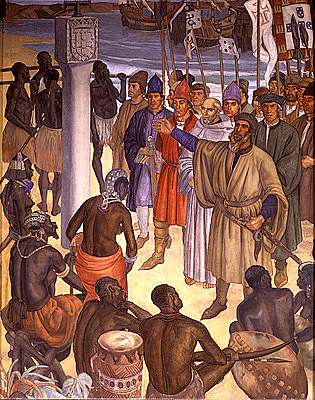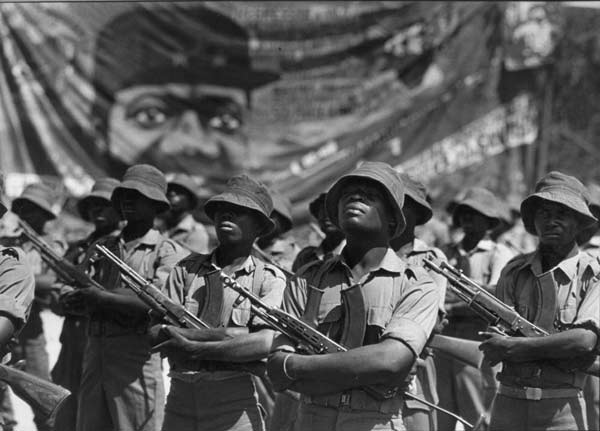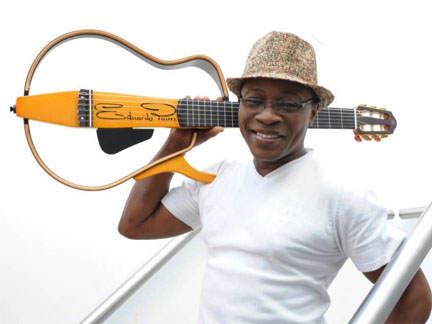We love this dance and we love this music!
Anyone who somehow became a Kizomba fan had a defining moment (seeing a Youtube video or seeing the dancers at a party) that made them decide they wanted to get to know this dance. Over time, however, questions may arise: What exactly is Kizomba? Where does it come from? Why is there this great disagreement and fight among teachers around the world? We may not get a proper education in the dance classes, in the worst case we don't even get to know where this dance and music came from. We dance it because it’s cool and popular, meanwhile we have a lot of fun and that’s okay. However, it is the responsibility of the teachers to properly inform and educate the students.
In short, Kizomba is a dance and musical style originated from Angola and developed to its present form in Lisbon in the 80s and 90s with the influence of other PALOP countries. For this reason, Lisbon is also called the capital of Kizomba.
New and exciting. It spread incredibly quickly in Europe and then around the world. It has changed just as fast. Everyone added or took something away from it, maybe misinterpreted it, BUT which is the point: everyone called it the same way, Kizomba. By the time the followers and representatives of the “real” Kizomba woke up, a new dance and music had already been born. That’s why there are so many arguments and fights about what should be called Kizomba.
For some, a lot of things remain hidden, things that are really important for understanding; as it is not just a dance, its formation is closely linked to the culture, history and tears of the Angolans and other PALOP nations.
Fusion of cultures
When Portuguese sailor Diogo Cão landed on the west coast of Africa in 1483, the Portuguese brought with them not only torment, suffering, and slavery to the African people, but also Western European culture, including couple dancing. Over the next five centuries, more and more Portuguese cultural elements merged into the dance and music, making it impossible to separate the two cultures.

Couple dances
Africans did not know couple dancing; although they had common traditional and tribal dances, such as, the traditional Anglo-African dance, Rebita (an African village dancing together for rain or a good harvest), these were not couple dances. The predecessor of Kizomba, Semba, on the other hand, is already a couple dance. Semba evolved from Massemba, meaning “touch of the bellies”, which signifies a typical movement in this dance.
Massemba:
The video shows the typical movement, the touch of the bellies.
The word: Kizomba
In its present form, Kizomba did not exist until 1975. The word in Kimbundu means "celebration". For them, these gatherings, “Kizombadas” were of outstanding significance, here they nurtured their culture, had good conversations, played on the dance floor with their dance partner.
The relationship: suffering and joy
The Portuguese enslaved and deported approximately 10 million African people. An estimated 1.5 million people died during the crossing and it is not known how many were killed during the manhunts and the fierce fighting. Each nation handles suffering differently. These people used dance to be able to forget and to bring a moment of joy into their life.
After decolonization
From 1975, the situation in Angola became dramatic due to the civil wars.

Many left the country and headed for Europe. How could they do that? People in the Portuguese colonies who had reached a certain level of civilization had similar rights as the Portuguese. They were the so-called Assimilados. These people had the opportunity to flee to Portugal, with Lisbon as their main destination, where they were already welcomed by Western civilization. They jumped right away into the nightlife of Lisbon because they wanted Kizomba, they wanted to celebrate.
Perception of life
It is important to mention that we Europeans can hardly understand these people. Because of our culture we are "programmed" differently. Mainly because of our Christian history, there are holidays where dancing is forbidden. This is completely unimaginable for the people of Angola like the following for us:
The Angolans celebrated EVERY occasion, so they held Kizomba (“celebration”) at weddings, birthdays, funerals, at the beginning of the war, at the end of the war, every time. Kizomba is their way of handling the pain, but also expressing joy. For anything that was of great emotional significance, whether joy or suffering, they danced together.
You often hear, "Enjoy every second as if it were your last!". It is difficult for us to apply this wisdom in our daily lives. However, the Angolans mastered this perfectly. The masters of enjoying every second with Kizomba, even if they would rather cry. To keep themselves from crying: they are dancing.
Evolution and misconceptions
Nowadays, talking about the evolution and history of Kizomba is not a simple thing. It is difficult to find evidence and facts in a sea of conflicts and misconceptions. Everyone claims it belongs to him and has their own story to it. It is indisputable that those who first began teaching were Angolans and Cape Verdeans, which is why the theory of these two peoples about the formation and evolution of the Kizomba may be the best known.
As the music changes, so does the dance.
Music evolution:
Kizomba has emerged as a more modern musical style, a softer style mixed with African rhythms, the Haitian Kompa and the Zouk from the French Antilles. The base of Kizomba is actually “Afro Caribbean French Zouk” . Many African countries have their own version of Zouk, or so called Afro-Zouk.
- The Angolan version of Afro-Zouk is Kizomba: a fusion between Zouk, Kompa and Angolan traditional music.
- Cape Verdeans call their Afro-Zouk music Cola-Zouk, Cabo-Zouk or Cabo-Love.
- The Guinea-Bissau version of Afro-Zouk is called Meia-Batida (half-beat).
Afro-Zouk is actually present in many other African countries: Congo, Mozambique, São Tomé and Príncipe, Nigeria etc.
Eduardo Paim - the father of Kizomba music

He was born in Angola, but as a child fled with his family to Congo, as the then Portuguese military dictatorship wanted to arrest them. In Congo, he evolved to a real musical talent. His music was influenced not only by his homeland, Angola, but also by the environment of Congo. In Congo, more modern (western) music was played on the radio, unlike in the Portuguese colonial Angola. When he managed to return to his homeland in 1974, he began playing his music to the Angolans. People liked it, but it confused them, they even asked him in an interview what kind of music he plays. With interest, they found out that it’s not Angolan, nor is it traditional music because he uses modern instruments such as the guitar. Eduardo didn’t want to pinpoint his musical style in the heat of the interview, so he said that this music has no name, it’s just fun and happiness. Because his parents were Kimbundu-speaking Angolans, he simply put it this way, "Guys, it's just Kizomba!" (so have fun and celebrate). And although he really just wanted to explain himself, thanks to this misunderstanding he managed to name his new music, which has since been called Kizomba. Therefore, in the PALOP countries, Eduardo Paim is considered to be the father of Kizomba.
Interview with Eduardo Paim, where he himself tells how his music was named Kizomba:
Dance evolution:
Before the word Kizomba was applied to the dance, the PALOP countries referred to it as Passada (Portuguese word, meaning: step). The Passada uses universal dance basics: stepping, walking and 360-degree turning. It is likely that these basics come from the European Waltz dance, which was spread by the Portuguese in the PALOP countries and was reshaped and danced by the African peoples according to their own interpretation. These universal basics can be found in almost every couple dance, such as Bolero, Son, Semba, Bachata, Tango and more. Each dance is a poof how different cultures have interpreted the basics of a dance differently, then changed it, shaped it in a way to reflect their personality and their own style.
Nowadays people only learn the finished product, Kizomba, where it is specified exactly what you need to do, but in the past it was different. Dancing could not be excluded from everyday life. They knew not only their own national dance, but many other dances that influenced the Kizomba from then, better said Passada.
The Angolans had a very rich dance culture. They had Semba and the carnival dances from which they were richly inspired. At dance gatherings, as mentioned earlier (before they called their dance Kizomba), the Angolans danced “Passada”. Kizomba as a dance started with the newer generation, when young people began to copy the movements of older people. Since the Kizomba took a lot of movements and elements from the Carnival Semba, we can say that Semba gave life to Kizomba.
Kizomba eventually was “assembled” in Lisbon, formed as we know it today, and then spread throughout Europe.
Lisbon, the capital of Kizomba
After decolonization, everyone who could, emigrated to Portugal because of the civil wars or in the hope of a better life. Not only Angolans were present in Lisbon, but also people from Cape Verde and other PALOP countries. These ethnic groups met with each other in dance. How could they do that? Everyone danced the Passada, everyone loved the Zouk and Kompa music.
At these parties, the Kizomba known today, slowly began to form. The Angolans used more and more movements of their style and Semba steps in their Passada dance. The other ethnic groups watched them in admiration, but whenever they asked what they were doing, the Angolans replied with “kizomba”, meaning “we celebrate, we party”. The others simply took over the word, as they were not Angolans, for them it just meant what they saw and heard.
Kizomba is the dance that developed after 1980 when Angolan, Cape Verdean, Portuguese and other PALOP Africans met in Lisbon.
Strictly speaking, the Kizomba dance created in today’s Lisbon is not Angolan or Cape Verde, and of course not Portuguese, but exclusively belongs to “Lisbon”. That is why Lisbon is the capital of Kizomba, not Luanda (the capital of Angola) or anything else.
On-Stage Kizomba
With Kizomba spreading in the late 1990s, and later also due to the growing popularity of the internet and video sharing sites, On-Stage Kizomba appeared. These were performances where the dancers needed the whole dance floor or stage as they have been spiced up their productions with acrobatic movements. For us Europeans, a dance only seems spectacular and technical when it is enriched with acrobatic elements and our attention is focused on the area above the waist. Kizomba in the other hand is an earth dance, so the movements and techniques are concentrated on the areas below the waist.
It is important to mention that in these videos the performers are not dancing to Angolan music, to be more precise not to Kizomba music, but to Ghetto Zouk.
At this point, everything has changed, and this is where a new argument started to form: What is that we can actually call Kizomba?
So what is Kizomba?
First, we need to ask back: Which Kizoma are we talking about? You mean, the Angolan Kizomba? The Lisbon Kizomba or the Kizomba we know today as Urban Kiz?
If we are talking about Lisbon Kizomba, anything that is not included in the image below, or a dance that cannot be traced back to this image, is not Kizomba.
As mentioned earlier, the capital of the Kizomba is Lisbon. Of course, Angolan people should never be told that Kizomba is from Lisbon. Officially, Kizomba is Angolan, just as the word itself is Angolan. The Angolans form the second largest community in Lisbon after the Portuguese. The majority of today’s Kizomba is theirs. The image above only gives a more detailed view without getting into an argument with the Angolan people. However, the role of the Cape Verdeans in Kizoma is also unquestionable.
The "Kizomba explosion" took place in Lisbon. And most of the components of the exploding “bomb” came primarily from Angola.
Kizomba fusion
The real Kizomba is not so easy to pass on if you are not a real PALOP. Why? These people grew up dancing Semba, Passada and other African dances.
First, we need to understand how the human body works. When we do some form of movement, such as dancing, the muscles store and memorize that form of movement - this is called muscle memory. When we say that a dance is in someone’s blood, it is exactly because of that, muscle memory. Of course, this does not mean that someone cannot be a dancer of the same level; it just depends on how much time and energy you put into mastering that particular dance.
Many people think it is enough to learn the steps, the so-called figures and after a few workshops they can already teach that dance. Shallow knowledge, on the other hand, is not enough for quality education.
Back to fusion: As Kizomba spread in Europe, people who were professional in other dances began to shape Kizomba to their own style. They used movements that were comfortable to their bodies: what their bodies had long known. A good example of this is Albir, who spices up his Kizomba dance with hip-hop moves and stylistic elements.
Dance of Albir Rojas and Sara Panero:
From these we can already conclude what Kizomba Fusion is: The evolution of the classical Kizomba extended with elements taken from other dances, yet preserving its basic steps and technique.
The question arises: Is this really the real Kizomba fusion?
In the evolution of a dance, it is natural that elements are taken and built in from other dances. However, when talking about fusion in the strict sense, it is important not to use a tango, hip-hop or salsa step exactly as it is. During a fusion we have to change the steps according to the rules and style of Kizomba so that it remains Kizomba and it won’t be, for example, a Kizomba with a salsa step.
Urban Kiz
Urban Kiz has gone through the process mentioned above, but during this has lost the original essence of Kizomba. The relation between the couples has changed: the energy is directed outward rather than towards our dance partner. More space is needed for the tricks and figures, the style of the steps has changed. The dance became tighter with frequent lifts, enriched with acrobatic elements. In short, it has been transformed to the style of the European man.
This dance is still evolving, constantly changing. It looks different than it did 3 years ago and is sure to change a lot more in the next 3 years as well. This is why the representatives of the classical Kizomba stood up and fought to preserve the dance they represented. Eventually, an agreement was made and a new name was given to this dance: Urban Kiz (Urban - refers to what style it represents, Kiz - means from what dance it comes from).
Urban Kiz:
It is also very important for students to distinguish between these styles. If we go to a festival we will know for sure what class we are attending: Kizomba, Kizomba Fusion or Urban Kiz.
Ghetto Zouk
In every African country where Zouk music appeared (from the French Antilles) and had an impact on local folklore, “local” styles also emerged in music and dance. This is also the case for the Cape Verdeans, who began to shape this music to their own style, creating Cabo-Zouk, also known as Cabo-Love.
Johnny Ramos - Father of Ghetto Zouk
Johnny Ramos, Nelson Freitas, Eddy Parker and Adilson Ben-David played an important role in the appearance of Ghetto Zouk. They had something in common - they were born in the Netherlands, but their parents were Cape Verdean. They were raised in two cultures and some of them are also relatives(see below). They started mixing Zouk and Western modern music. According to Johnny Ramos on the Zouk side his music was inspired by the band “Kassav”, and on the modern music side by R&B, hip-hop and everything that could be heard on Dutch radio.
They first started singing in a boy band called “Quatro Plus” and their own record label, Miss Jane Records, released their music. Where does this name come from?
J = Johnny Ramos
A = Adilson Ben-David (ToetStar)
N = Nelson Freitas - Johnny's nephew
E = Edson Freitas (Eddy Parker) - Nelson's brother
The band debuted in the album “Mobass presents” in 1997, in which they had already attempted to create something new: mixing Cabo-Zouk with modern music.
Although the term has already been used among themselves, the first music officially named Ghetto Zouk - as a musical style - was Johnny Ramos' song named "Largal" released in 2004:
When Johnny Ramos started experimenting with this, the initial Ghetto Zouk was created for the African people, so it sounded more like a Kizomba. When Nelson Freitas started his solo carrer with Ghetto Zouk, he added more R&B elements and moved further away from the rhythm of Zouk. From then on, Western Europeans paid more attention to the music, was closer to their style.
Interview with Johnny Ramos about the appearance of Ghetto Zouk:
Tarraxinha
Tarraxinha, as a musical style evolved from Zouk-Love, as a dance it is danced as a style of Kizomba. It comes from the Portuguese verb “atarraxar,” which means “to screw”
Conjugation:
- eu - tarraxo
- tu - tarraxas
- ele - tarraxa
- nós - tarraxamos
- vós - tarraxais
- eles - tarraxam
Tarraxinha, as a dance, is said to come from Angola. His predecessor was a dance called Charo Chato, which is now the first basic step in Kizomba. This was danced to slow music, love songs and Bolero.
Ghetto Zouk comes from Cape Verde’s Cabo Love or Zouk Love, which is a soft and romantic music. Tarraxinha also evolved from this. Nowadays, we also dance Kizomba on the Ghetto Zouk. There are fast and slow parts in this music. In the slower parts, we usually dance Tarraxinha, in place or just base 1, in which case the Ginga and Banga, female and male styles are more highlighted, have more accent.
It is important to know that in Tarraxinha, the man does not rub his upper thigh to the lady's "region", not even to the inside or top of the woman's thigh! It’s sexual, not sensual, and certainly is not Tarraxinha.
Because the Ginga and Banga have more accent, some misinterpreted the movements of Tarraxinha. Rubbing and imitation of reproductive movements characterized the dance. It was reaching a point where for some people it was already danced sex. The main idea of Kizomba, however, is no longer fulfilled at this point, which is as follows: "What you cannot dance with your mother and daughter is not Kizomba."
Dance of Joao and Giedre Tarraxinha:
You need to be nice, calm and relaxed. The direction of Ginga-movements mainly are: back and then upward, finally returning to a neutral position. Most importantly, this movement never starts from this neutral position towards the male genitalia. The man leads accordingly, so the bunda (buttocks in Portuguese) moves backwards and then upwards. The man does not pull the woman towards him, yet this can be seen very often at some dancers.
Albir and Carola, no matter how good they look, are not dancing Tarraxinha:
The mysterious Kizomba Ladystyling can also be the reason for this. Kizomba is 100% Ginga, nothing else. The woman is not styling in Tarraxinha, she is naturally beautiful. That is what Ginga actually means!
This is why the largest and most influential dance schools in Portugal have come together to clearly define the dance rules and techniques of Tarraxinha (including Kizomba).
Have a look at Vanessa, Master Petchu's partner, the Queen of Ginga:
Finally, here is Joao Rocha's explanation about Tarraxinha:



